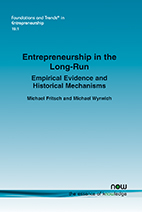Entrepreneurship in the Long-Run: Empirical Evidence and Historical Mechanisms
By Michael Fritsch, Friedrich Schiller University Jena, and Halle Institute for Economic Research (IWH), Germany, m.fritsch@uni-jena.de | Michael Wyrwich, University of Groningen, The Netherlands, and Friedrich Schiller University Jena, Germany, m.wyrwich@rug.nl
Abstract
We review and discuss research on the development of regional entrepreneurship over time. A particular focus is on the long-term persistence of regional levels of entrepreneurship, its explanation, and its meaning for economic development. What is the state of empirical research in this field, and what can explain the empirical findings? How are long-term trends of entrepreneurial activity linked to regional performance in terms of employment, gross domestic product (GDP), and innovative activity? Based on our assessments we derive conclusions for theory, policy implications, and avenues for further research.
Entrepreneurship in the Long-Run: Empirical Evidence and Historical Mechanisms
Entrepreneurship in the Long-run: Empirical Evidence and Historical Mechanisms reviews the available evidence on the historical roots of entrepreneurship and its relationship with economic performance across regions, which is defined as subnational geographic entities. Given the tremendous differences in the level and the type of entrepreneurship between regions, the authors focus on the regional level and demonstrate how historical factors can determine entrepreneurial activity in a region and may predetermine future development paths. In addition, the monograph looks at the ability of a regional economy to cope with external challenges. The main explanation for such long-term effects and for the persistence of the level of regional entrepreneurship over long periods are historically rooted regional cultures that change only very slowly. Generally, historical roots provide a key explanation for the development of regions along long-term trajectories that are characterized by a co-evolution of entrepreneurship, knowledge, and informal institutions. This means that regions can have persistently low or persistently high levels of entrepreneurship depending on whether historical factors shaped entrepreneurship positively or negatively.
Following a brief introduction, the monograph starts with a brief overview of data availability and measurement (Section 2), summarizing the available empirical evidence on long-term trends in regional entrepreneurship in Section 3. Section 4 discusses potential explanations for these findings. Section 5 is devoted to the effects of persistent regional entrepreneurship on economic development. Based on these findings the authors discuss theory development in Section 6 and derive policy implications in Section 7. Section 8 reviews empirical challenges and describes the main avenues for further research. Section 9 provides the authors’ conclusions.
